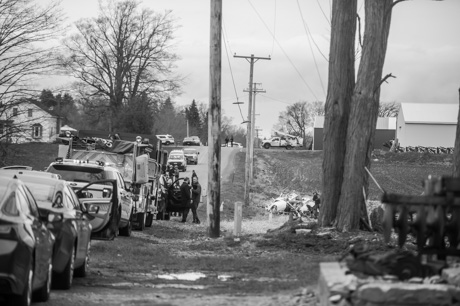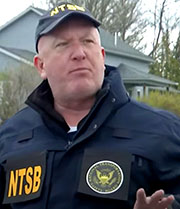
There have been nine accidents involving the Bell 429, the model helicopter being flown by James E. Sauer, 60 of Churchville, and Stewart M. Dietrick, 60, of Prosper, Texas, when it went down in a field near Norton Road in Elba at 1 p.m. Wednesday.
The National Transportation Safety Board has determined the cause of four of those accidents. Three of them were the result of human error and one was an apparent mechanical failure.
The preliminary evidence in Wednesday's crash of the Mercy Flight aircraft, said Aaron McCarter, air safety investigator with the NTSB, is that the rear tail section of the aircraft became detached during the flight.

"Onboard (the helicopter) were two pilots and seasoned professionals about 1300 or 1 p.m. local time, several credible witnesses of the helicopter transitioning the area behind me over Elba, New York, at about 2,000 feet observed and heard a loud boom. We don't know which occurred first (the tail separating or the boom). The tail separated from the helicopter and was found 300 feet from the main wreckage."
The main wreckage was in a gully just a few yards from the edge of Norton Road, about a mile north of Edgerton Road.
McCarter said he will be at the accident scene gathering evidence for three to five days.
"The on-scene portion of the investigation is only a small part of a much larger list, or process," he said. "Most of the work being done by the investigative team happens behind the scenes when the on-scene portion is over. In 10 days, I will be completing the preliminary report. In approximately 12 months, the factual report, followed very shortly by the probable cause, signed off by the Transportation Safety Board members (will be released)."
The cause won't be determined until the investigation is complete, and that investigation, regardless of what the evidence shows now, looks at all factors of the case, McCaster said. That includes mechanical, environmental, and human elements, and how all three elements interacted.
While both Sauer and Dietrick are experienced pilots, they were on a training mission.
"Even though they are seasoned pilots, you know how much time they had in this particular helicopter?" McCarter said. "I'm not trying to equate aircraft with cars, but have you ever gotten to a car rental that was completely different than yours? It takes you a while to kind of figure out where all the buttons are and how how to maneuver. So that's what we're looking at, we're looking at their familiarity with the machine, how much experience did they have in this particular machine, in addition to all the other aircraft that they have flown."
Wreckage to be examined in Delaware
The wreckage, which was spread over a 2,000-foot area from beginning to end, will be transported to Clayton, Delaware.
"It will be transported back to this facility to a two-dimensional assembly of it on a hangar floor and we'll be able to see how the helicopter -- it can assist us in determining how the helicopter came apart and what happened first."
He added, "We will be doing a thorough engine check. We're gonna be checking on the rotor blades. We're gonna be checking the tail rotor. And we're gonna be downloading data."
While the Bell 429 doesn't have a "black box" as most people are familiar with -- its data isn't in a hardened protective case -- McCarter is confident the flight recorder data can be recovered.
Investigators will also look at flight and maintenance logs and any reports on the helicopter's performance on previous flights.
The aircraft was manufactured in Canada so by international treaty, Canadian aviation experts will be participating in the investigation.
McCarter indicated he doesn't believe there was anything of the ordinary for a training mission prior to the crash. The mission started at the Genesee County Airport at 11:15 a.m. and the crew did a typical training flight pattern around the airport for about an hour before heading toward Elba.
Once the tail separated, McCarter said, the pilot would have found it impossible to maintain directional control over the aircraft.
"That tail rotor is what keeps the nose of the helicopter pointed in the correct direction," he said. "Because the torque when the rotor blades are spinning around the helicopter, the fuselage wants to spin in the opposite direction, if you remember your high school physics, so the tail rotor actually keeps the nose of the helicopter pointed in a specific direction."
Of the nine prior crashes involving the Bell 429, four claimed six lives.
Prior aviation crashes locally
Of the nine Bell 429 crashes, one was in Batavia on Oct. 6, 2021. That 429 was also owned and operated by Mercy Flight but was not the same aircraft involved in Wednesday's accident. There were no injuries when that helicopter had a hard landing at the Genesee County Airport. The cause has not yet been determined.
There has been one other helicopter crash in Genesee County over the past 30 years. On Dec. 27, 2003, in Byron, when a pilot practicing autorotations over an airport open field made a hard landing. The pilot was seriously injured.
The NTSB reported, "The pilot reported that he felt a shudder during the autorotation and tried to regain airspeed by using forward cyclic, but he was unable to regain airspeed. Examination of the helicopter found evidence of low main rotor rpm. No discrepancies were found with the flight controls and engine."
Previous airplane accidents, as reported by the NTSB, in Genesee County:
- March 31, 1983, Batavia, Cessna 182, mechanical failure, four aboard, no injuries;
- Sept. 24, 1983, Batavia, Cessna 152, an unexpected gust of wind on landing, two aboard, no injuries;
- Oct. 7, 1984, Cessna 150H, pilot error at dusk, no injuries;
- May 17, 1985, Batavia. Piper PA-22-150, commercial-rated flight instructor encountered unexpected wind at takeoff, no injuries;
- May 29, 1985, Batavia, Piper PA-28-235, loss of power during takeoff, two aboard, no injuries;
- Oct. 15, 1986, Le Roy, Piper PA-38, instructor error, two aboard, no injuries;
- June 20, 1987, Batavia, Cessna 177RG, mechanical failure resulting in an emergency landing, no injuries;
- March 17, 1991, Le Roy, Cessna 172M, inexperienced pilot error in poor lighting conditions, four aboard, no injuries;
- Feb. 15, 2004, Batavia, Cessna 172E, the inability of the pilot to maintain control in winds on an icy runway, no injuries;
- June 15, 2007, Cessna 172s, student pilot error, no injuries;
- Feb. 7, 2009, Le Roy, Cessna 172A, pilot error in heavy winds, no injuries;
- July 15, 2011, Batavia, Murphy Aircraft Elite, pilot error, one serious injury;
- Aug. 2, 2012, Alexander, Piper PA-25-260, pilot error, no injuries;
- Sept. 20, 2014, Bethany Center, Cessna 182A, pilot error, no injuries;
- June 11, 2915, Le Roy, Brandt Leroy E Challenger II, pilot error, no injuries;
- Oct. 27, 2019, Batavia, Beech A36, pilot error in heavy winds, four aboard, no injuries;
- June 1, 2020, Le Roy, Beech 36, pilot error, no injuries.
The only other fatal aviation crash in Genesee County since the early 1980s was on Oct. 2, 2020, in Corfu, which claimed the lives of attorneys Steve Barnes and Elizabeth Barnes. The cause of that crash remains undetermined.
CORRECTION: There was another fatal airplane crash in Genesee County on Aug. 11, 2001. Two people were killed when a Dominiak Kitfox crashed in Byron. Alcohol and drugs were found in the inexperienced pilot's blood.
